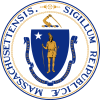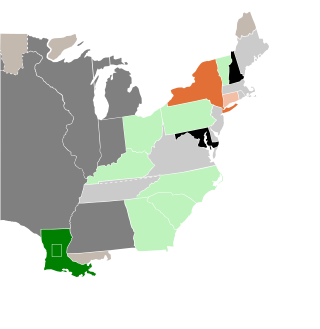| Elections in Massachusetts |
|---|
 |
Massachusetts gained three seats after the 1810 census, all of which were added to the District of Maine. Its elections were held November 5, 1812, but since Massachusetts law required a majority for election, which was not met in the 19th district , a second ballot was held there January 6, 1813.
| District | Incumbent | This race | |||
|---|---|---|---|---|---|
| Representative | Party | First elected | Results | Candidates | |
| Massachusetts 1 "Suffolk district" | Josiah Quincy | Federalist | 1804 | Incumbent retired. New member elected. Federalist hold. | √ Artemas Ward Jr. (Federalist) 98.7% Others 1.3% |
| Massachusetts 2 "Essex South district" | William Reed | Federalist | 1810 | Incumbent re-elected. | √ William Reed (Federalist) 56.1% Benjamin W. Crowninshield (Democratic-Republican) 43.9% |
| Massachusetts 3 "Essex North district" | Leonard White | Federalist | 1810 | Incumbent retired. New member elected. Federalist hold. | √ Timothy Pickering (Federalist) 95.6% Others 4.4% |
| Massachusetts 4 "Middlesex district" | William M. Richardson | Democratic-Republican | 1811 (Special) | Incumbent re-elected. | √ William M. Richardson (Democratic-Republican) 51.8% Asahel Stearns (Federalist) 46.8% William Reed (Democratic-Republican) 1.4% |
| Massachusetts 5 "Hampshire South district" | William Ely | Federalist | 1804 | Incumbent re-elected. | √ William Ely (Federalist) 67.5% Enos Foot (Democratic-Republican) 19.6% Joseph Lyman (Federalist) 11.3% Samuel Fowler (Democratic-Republican) 1.6% |
| Massachusetts 6 "Hampshire North district" | Samuel Taggart | Federalist | 1803 | Incumbent re-elected. | √ Samuel Taggart (Federalist) 87.3% Solomon Snead (Democratic-Republican) 9.3% Joseph Rice (Federalist) 3.4% |
| Massachusetts 7 "Plymouth district" | Charles Turner Jr. | Democratic-Republican | 1808 | Incumbent lost re-election. New member elected. Federalist gain. | √ William Baylies (Federalist) 59.0% Charles Turner Jr. (Democratic-Republican) 41.0% |
| Massachusetts 8 "Barnstable district" | Isaiah L. Green | Democratic-Republican | 1810 | Incumbent lost re-election. New member elected. Federalist gain. | √ John Reed Jr. (Federalist) 67.9% Thomas Hazard Jr. (Democratic-Republican) 26.5% Isaiah L. Green (Democratic-Republican) 5.6% |
| Massachusetts 9 "Bristol district" | Laban Wheaton | Federalist | 1808 | Incumbent re-elected. | √ Laban Wheaton (Federalist) 60.2% John Hawes (Democratic-Republican) 39.8% |
| Massachusetts 10 "Worcester South district" | Elijah Brigham | Federalist | 1810 | Incumbent re-elected. | √ Elijah Brigham (Federalist) 55.1% Estes Howe (Democratic-Republican) 44.4% Jonas Sibley (Democratic-Republican) 0.6% |
| Massachusetts 11 "Worcester North district" | Abijah Bigelow | Federalist | 1810 | Incumbent re-elected. | √ Abijah Bigelow (Federalist) 76.6% Edmund Cushing (Democratic-Republican) 23.4% |
| Massachusetts 12 "Berkshire district" | Ezekiel Bacon | Democratic-Republican | 1807 (Special) | Incumbent retired. New member elected. Federalist gain. | √ Daniel Dewey (Federalist) 53.4% Samuel Wheeler (Democratic-Republican) 46.6% |
| Massachusetts 13 "Norfolk district" | Ebenezer Seaver | Democratic-Republican | 1803 | Incumbent lost re-election. New member elected. Federalist gain. | √ Nathaniel Ruggles (Federalist) 55.3% Ebenezer Seaver (Democratic-Republican) 44.7% |
| Massachusetts 14 "1st Eastern district", District of Maine | Richard Cutts | Democratic-Republican | 1801 | Incumbent lost re-election. New member elected. Federalist gain. | √ Cyrus King (Federalist) 59.3% Richard Cutts (Democratic-Republican) 37.8% Others 2.9% |
| Massachusetts 15 "2nd Eastern district", District of Maine | William Widgery | Democratic-Republican | 1810 | Incumbent lost re-election. New member elected. Federalist gain. | √ George Bradbury (Federalist) 58.2% William Widgery (Democratic-Republican) 41.8% |
| Massachusetts 16 "3rd Eastern district", District of Maine | None (District created) | New seat. New member elected. Federalist gain. | √ Samuel Davis (Federalist) 61.5% Benjamin Ames (Democratic-Republican) 38.5% | ||
| Massachusetts 17 "4th Eastern district", District of Maine | None (District created) | New seat. New member elected. Democratic-Republican gain. | √ Abiel Wood (Democratic-Republican) 85.5% Joshua Head (Federalist) 5.8% Others 8.8% | ||
| Massachusetts 18 "5th Eastern district", District of Maine | Francis Carr Redistricted from the 17th district | Democratic-Republican | 1812 (Special) | Incumbent lost re-election. New member elected. Federalist gain. | √ John Wilson (Federalist) 57.7% Francis Carr (Democratic-Republican) 42.3% |
| Massachusetts 19 "6th Eastern district", District of Maine | None (District created) | New seat. New member elected. Democratic-Republican gain. | First ballot (November 5, 1812): James Parker (Democratic-Republican) 49.3% Thomas Rice (Federalist) 49.0% Others 1.7% Second ballot (January 6, 1813): √ James Parker (Democratic-Republican) 54.8% Thomas Rice (Federalist) 45.2% | ||
| Massachusetts 20 "7th Eastern district", District of Maine | None (District created) | New seat. New member elected. Democratic-Republican gain. | √ Levi Hubbard (Democratic-Republican) 52.6% Ebenezer Fessenden (Federalist) 47.4% | ||












